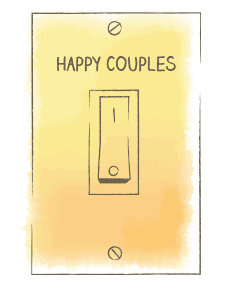DIVORCE PREVENTION: THE LIGHT SWITCH OF LOVE DILEMMA
Kyle Benson

Love is like a light switch.
When people fall in love, the light turns on. They typically feel excited, captivated, and eager to get to know their partners. They see each other in a positive light.
When couples divorce, the most common reason is that they “grew apart.” Essentially, the light switched off at some point.
So what happened?
The way it plays out reminds me of something from my childhood imagination.
As a child, I used to hate when my parents turned off my bedroom light.
I would start seeing Batman in my closet and fear that he was going to kidnap me.
When an earthquake would happen while I was sleeping, my first thought was that the Joker (from Batman) was under my bed trying to get me.
When the light switch was off, I would imagine all the worst things happening.
This happens in relationships too.
When the light is on, couples will experience negative events in the relationship, yet still evaluate the relationship as satisfying overall.
However, as negative experiences accumulate (without repair and constructive changes), the light switch reaches a tipping point.[1]
It turns off.
All of a sudden we evaluate our relationship as dissatisfying.
With the lights off, our brains imagine the worst intentions of our partner.
Of the 19% of couples who seek out help with their marital challenges, most start couples therapy with the lights off, as evidenced by research revealing that couples wait six years on average before seeking outside help.[2]
As a result, they have to accumulate a lot of positive experiences while having a dissatisfying view of their relationship just to turn the light switch on. That’s hard.
It’s like my dad telling me Batman isn’t in my bedroom closet, but my imagination saying he is. I want to trust my dad, but my brain is screaming “See! See! There’s Batman.”
Research confirms this. When we have a negative perspective of our partner, we even misinterpret the neutral and positive actions of our partner as negative.[3]
The divorce rate for first marriages in the U.S. is around 45% and the divorce rate for subsequent marriages is even higher.[4] Despite these high numbers, only a third of couples who divorce work with a counselor, coach, or therapist before signing the papers.[5]
What this illuminates is that there are opportunities to repair and strengthen a relationship before the light switches off.
Like most things in life, prevention is often the best intervention.
The goal of prevention includes three key steps:
- Stop negative interactions in a relationship from eroding trust, emotional connection, and intimacy.
- Catch the accumulating problems early and turn the issues into material to construct a stronger and more secure relationship.
- Proactively strengthen both a couple’s friendship and their emotional and sexual intimacy while exploring ways to create a meaningful bond.
Let’s keep the lights on,
Kyle
P.S. Prevention options are listed below.
P.S.S. While this article is pro-relationship, it is not my position to decide whether you should stay or leave a relationship. After all, it is your love life. Clients who have worked with me know that I am not pro-relationship or pro-separation. My goal is to help the couple clean things up so they can decide for themselves from a mature place. I would also say that I have recommended people leave abusive, or unhealthy relationships in which partners do not want to become secure-functioning.
Prevention Options:
- Bibliotherapy: Books and articles can help you improve your relationship. Ideally, both partners engage with this. My top three book suggestions are Eight Dates: Essential Conversations for a Lifetime of Love, Fighting For Your Marriage (this one has a DVD with example conflict conversations), and Relationship Rx.
- Psychoeducational: This includes online courses and in-person workshops. My top three suggestions include The 7-Day Emotional Connection Challenge, a live event such as The Art and Science of Love, The Seven Principles For Making Marriage Work (Google search in your area), and Hold Me Tight (Google search in your area), or completing other online evidenced-based courses such as OurRelationship.com and Rock Solid Marriage.
- Take an Annual Couple Checkup: Research from Clark University in Oregon indicates that having an annual marriage checkup can positively decrease the chances of a relationship getting worse and help strengthen a relationship overtime. All of us do health checkups, shouldn’t we do the same for our marriage? If you’re in Oregon, you can check it out here. You can also take the Couples Checkup by Prepare-Enrich here (they also send you a variety of discussion questions to support you in making changes). Another checkup option is RELATE.
- Seek Personalized Support: If you are on the brink of divorce, I might recommend starting with Discernment Counseling before starting therapy. Furthermore, therapy and coaching offer a variety of ways to receive one-on-one support. Depending on your needs, you can do marathon therapy, weekly sessions, or virtual sessions via video chat. I’d recommend working with someone who has professional training in couples therapy. Here are some places you can search for a therapist near you: Gottman Therapist, Emotionally Focused Couples Therapist, PACT Therapist, AASECT (for support with sex and intimacy challenges) and Imago Therapist.
Sources
[1]Gottman, J. M., Silver, N., & Berkrot, P. (2012). What makes love last?: how to build trust and avoid betrayal. Old Saybrook, CT: Tantor Media.
[2]Johnson, C., Stanely, S., Glenn, N., Amato, P., Nock, S., Markman, H., & Dion, M. (2002). Marriage in Oklahoma: 2001 baseline statewide survey on marriage and divorce (SO2096 OKDHS). Oklahoma City, OK: Oklahoma Department of Human Services.
Gottman, J. M. (1994). What predicts divorce? The relationship between marital processes and marital outcomes. Hillsdale, NK: Lawrence Erlbaum Associates
[3]Robinson, E. A., & Price, M. G. (1980). Pleasurable behavior in marital interaction: An observational study. Journal of Consulting and Clinical Psychology , 48(1), 117-118 DOI: 10.1037/0022-006X.48.1.117
[4]https://www.fatherly.com/love-money/what-is-divorc…
[5]Johnson, C., Stanely, S., Glenn, N., Amato, P., Nock, S., Markman, H., & Dion, M. (2002). Marriage in Oklahoma: 2001 baseline statewide survey on marriage and divorce (SO2096 OKDHS). Oklahoma City, OK: Oklahoma Department of Human Services.



